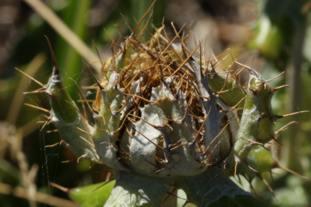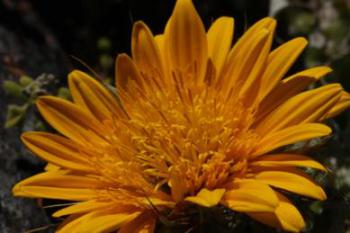Berkeya barbata
Berkheya barbata ( L.f.) Hutch.
Family: Asteraceae
Common names: coast thistle (Eng.); kus-dissel (Afr.)
Introduction
A beauty to admire but painful to touch: handle with care. These sunflower-like daisies often make very attractive displays, but the thorns on the leaves, stems and bracts hamper its potential as a cut-flower.

Description
Description
Berkheya barbata is perennial and can grow up to 60 cm tall, although it is often much smaller. Plants produce multiple stems from a woody underground stem to form densely entangled shrubs, or scramble over rocks and other vegetation. Young leaves and stems are covered by a cotton-like layer of soft white hairs, which rubs off as the parts mature. Leaves are arranged in pairs, up to 60 mm long and 25 mm wide, bright green and glossy above and with a white dense hairy cover below. Leaf margins have 4-9 pairs of spines as well as one spine on the leaf tip.

Single flower heads are borne on unbranched stems, about 100-150 mm long. Heads are often as large as the palm of a hand (up to 100 mm across) and have an outer ring of bright yellow to orange-yellow ray flowers with matching coloured disc flowers in the centre. Heads are supported by several rows of spiny bracts similar to the leaves. These bracts are persistent and form a hard protective cover for the seeds at the end of the flowering period. Plants flower from October to January.

Conservation Status
Status
Berkheya barbata is quite common and widespread and is therefore of little concern to conservationists (the status was evaluated as Least Concern).
Distribution and habitat
Distribution description
Berkheya barbata is found in the Western Cape, particularly along the coast between Gansbaai and the Cape Peninsula. Most of the herbarium records are from localities within 1 km of the coastline, but there are a number of records from further inland. It grows on sand derived from Table Mountain Sandstone, and is mostly found in rocky areas, deep sand or hanging from cliffs. Along the rocky coast it often covers extensive areas where it successfully tolerates harsh windy conditions and salt spray.

Derivation of name and historical aspects
History
The genus Berkheya was founded by a German botanist, Ehrhart, in 1788, who named it in honour of the Dutch botanist, Jan Le francq van Berkhey (1729-1812). The specific name barbata, derived from the Latin barbatus for bearded, refers to the characteristic long white hairs found on the young leaves and stems.
Ecology
Ecology
Flowers are pollinated by generalist pollinators such as bees and flies. Monkey beetles and other beetles are also often found on Berkheya flowers, but are more likely to be predators.
Seeds are small and light with a ring of scale-like bristles on the upper end and stiff hairs covering the surface assisting in the dispersal by wind.
Plants resprout from the rootstock and are among the first plants to flower after a fire.

Uses
Use
Although this species of Berkheya is not currently available commercially, it has the potential to be explored as a garden subject for coastal gardens. It tolerates harsh conditions and makes a very rewarding display of large, bright yellow flowers in summer. It can be planted in sunny areas between rocks, on a slight slope or as a ground cover in flower beds.

Growing Berkeya barbata
Grow
Propagate plants from seed. Seeds are white-hairy and are often parasitized, so ensure that you obtain fertile seeds. Sow seeds in sand, in a seed tray or directly in the soil. In nature, seeds would probably germinate in autumn when the rains come and plants would be sufficiently established to survive the next dry summer.
References
- Bean, A. & Johns, A. 2005. Stellenbosch to Hermanus . South African Wild Flower Guide 5. Botanical Society of Southern Africa, Cape Town.
- Eliovson, S. 1973. South African wild flowers for the garden . Macmillan, Johannesburg.
- Karis, P.O., Funk, V.A., McKenzie, R., Barker, N. & Chan, R. 2009. Arctotideae. In V.A. Funk, A.Susanna, T. Stuessy & R. Bayer (eds) 2009. Systematics, evolution, and biogeography of Compositae. IAPT, Vienna.
- Kesting, D. & Clarke, H. 2008. Botanical names, what they mean . Friends of Silvermine Nature Area.
- Leistner, O.A. (ed.) 2000. Seed plants of southern Africa: families and genera. Strelitzia 10. National Botanical Institute, Pretoria.
- Mustart, P., Cowling, R. & Albertyn, J. 1997. Southern Overberg . South African Wild Flower Guide 8. Botanical Society of South Africa, Cape Town.
- Raimondo, D., Von Staden, L., Foden, W., Victor, J.E., Helme, N.A., Turner, R.C., Kamundi, D.A. & Manyama, P.A. (eds) 2009. Red list of South African plants 2009. Strelitzia 25. South African National Biodiversity Institute, Pretoria.
- Van Rooyen, G. & Steyn, H. 1999. Cederberg, Clanwilliam and Biedouw Valley . South African Wild Flower Guide 10. Botanical Society of Southern Africa, Cape Town.
Credits
Marinda Koekemoer & Rabelani Rambau
National Herbarium Pretoria
January 2013
Plant Attributes:
Plant Type: Perennial
SA Distribution: Western Cape
Soil type:
Flowering season: Early Summer
PH:
Flower colour: Yellow
Aspect: Full Sun
Gardening skill: Challenging
Special Features:
Horticultural zones








Rate this article
Article well written and informative
Rate this plant
Is this an interesting plant?
Login to add your Comment
Back to topNot registered yet? Click here to register.